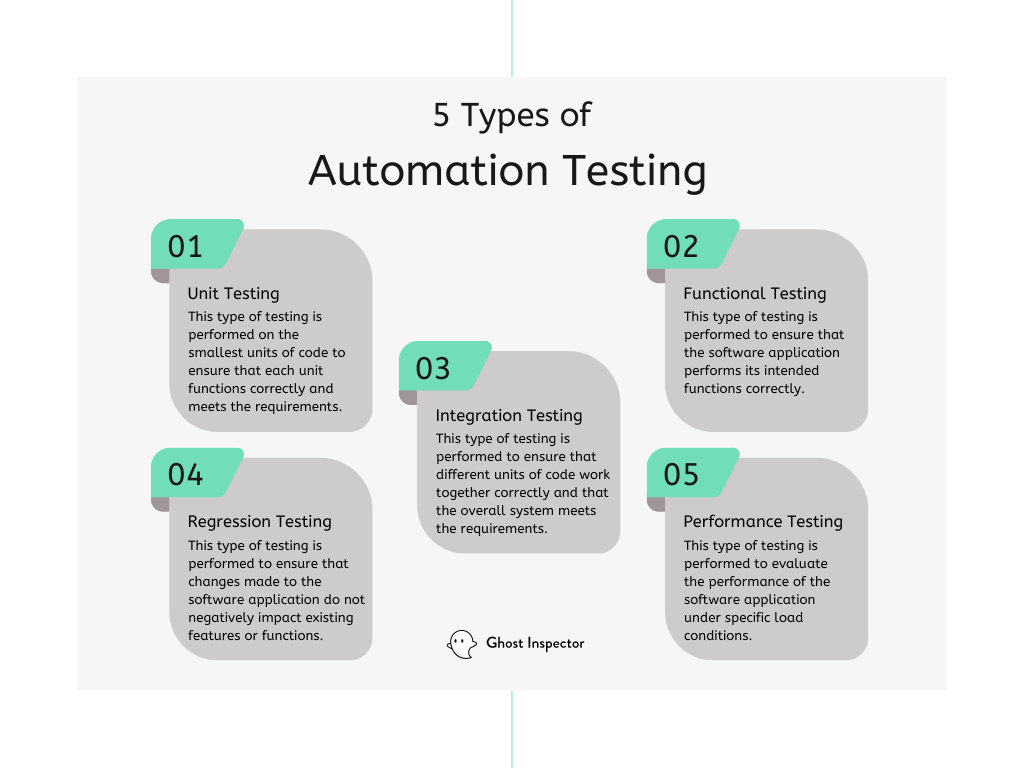We recently wrote a post about Test Automation Best Practices, but we think this topic deserves a deeper dive for those who might be curious about the basics of automation testing, how it can transform your QA process, and how to get started with a tool like Ghost Inspector. Let’s start by understanding what it is and how it works.
Table of Contents
What is Automation Testing?
Automation testing is a software testing technique that uses tools and frameworks to execute pre-defined test cases automatically. The process involves checking the functionality, UI, and performance of your product or website to ensure it’s working as expected.
Automation testing is an essential part of any software development cycle. It helps to identify bugs and errors early in the development process, saving time and resources in the long run. It can also be used for various types of testing, including unit testing, integration testing, functional testing, regression testing, performance testing, and acceptance testing.
How Does Automation Testing Work?
Automation testing works with the help of a testing tool. Typically, a test case is created and added to the platform, which will then execute it automatically at a pre-defined cadence.
Automation testing tools are designed to simulate real-world scenarios and user interactions, such as:
Checkout process
Mouse clicks
Form submissions
Keyboard inputs
This enables testers to identify potential issues with the UI and ensure that the application is easy to use.
Automated testing tools can also be used to test the performance of an application. They can simulate different types of user loads and analyze the application’s response time. This helps to identify potential bottlenecks and performance issues early in the development process.
In addition to identifying bugs and errors, automation testing can also help to improve the overall quality of the software. By automating repetitive and time-consuming tests, developers can focus on more critical areas of the application, such as new features and functionality.

The Advantages of Automation Testing
Now that we’ve talked about what automation testing is and how it works let’s dive into how it might be able to help your QA team.
Early Bug Detection
Our mantra at Ghost Inspector is “Catch bugs before they cost you.” If you’re reading this article, you know how imperative it is to uncover problems on your website or app BEFORE your customers do! With a solid automation testing tool, you’ll be notified right away when something breaks so developers can fix it before the issue becomes critical.
Improved Test Efficiency
Efficiency is without a doubt the biggest benefit of automation testing. Your team can test software during every stage of development, and it’s easily scalable to run thousands of tests. This approach is significantly faster than manual testing, saving time and resources.
Speaking of resources, depending on which automation tool you choose, you may not even need a developer to create your tests. Many Ghost Inspector users don’t have coding experience and are easily able to create and run their test suites because of how user-friendly and intuitive it is. This means your developers can spend their time on more critical matters that will move your business forward.
Increased Test Coverage
Automation testing can also cover a broader range of scenarios, including the ones deemed difficult or not possible to replicate manually. This means that more tests can be executed in a shorter time, and thus better coverage of edge cases.
Moreover, automation testing can simulate real-world scenarios, including user behavior and interactions, which are difficult to replicate manually. This means that developers can identify and fix defects that would have been missed in manual testing.
Reusability of Test Scripts
When you’re creating tests, it’s important to consider reusability – AKA, don’t reinvent the wheel for every single test. If you focus on building modular tests that you can reuse, you’ll avoid wasting a ton of time re-creating tests.
Start automation testing with Ghost Inspector
Our 14 day free trial gives you and your team full access. Create tests in minutes. No credit card required.
Integrating Automation Testing into the QA Process
Manual testing has its place, of course, but with the increasing complexity of apps these days, it can be super tedious and time-consuming. This is where automation testing comes in. Automation testing can help speed up the testing process, reduce errors, and improve the overall quality of the software.
So, where do you begin? Let’s take a look at some basic steps to integrating automation testing into your QA process.
Selecting the Right Automation Testing Tools
Depending where you’re at in the decision process, you may have already starting Googling different testing tools. There are several options on the market, but the right choice really comes down to a few key factors:
- Capabilities/features
- Ease of use
- Cost
- Compatibility with other tools
- Support for multiple platforms and browsers
- Customer support
If you have an idea of what you need, it’ll make your search a lot easier. If you’re considering Ghost Inspector as an option, I’d encourage you to take a look at how we stack up to our competitors.
Creating a Test Automation Strategy
A well-thought-out strategy is essential to avoid inefficiencies in the testing process. The test automation strategy should include elements such as:
- Test case selection
- Maintenance of scripts
- Test data sets
The strategy should also consider the frequency of testing, the scope of testing, and the expected outcomes.
Test case selection is critical in ensuring that the automated tests cover all the necessary scenarios. The maintenance of scripts is also essential to ensure that the automated tests remain relevant and up to date. Test data sets should also be carefully selected to ensure that they cover all possible scenarios.
Implementing Automation Testing in Agile Environments
Agile development is a methodology that emphasizes collaboration, flexibility, and customer satisfaction. Incorporating automation testing in agile development environments requires collaboration between QA, development teams, and automation testing teams.
A feasible strategy, cooperation, and communication between these stakeholders lead to the successful integration of automated testing in the development cycle. The testing team should work closely with the development team to identify the areas that require automated testing. The QA team should also be involved in the testing process to ensure that the automated tests meet the required quality standards.
Overcoming Challenges in Automation Testing
Automation testing has become a crucial aspect of software development, with companies embracing it to improve the quality of their products while reducing the time and resources spent on manual testing. Despite the significant benefits it provides, automation testing is not without its challenges. Below are ways to overcome some of the most common issues encountered when implementing automated testing.
Addressing High Initial Costs
One of the biggest challenges of implementing test automation is the high upfront costs involved. This can include the cost of purchasing automation tools, hiring automation engineers, and training team members on the new processes. However, automation testing pays off in the long run by reducing the time and resources spent on manual testing. When considering implementing automation testing, it’s important to factor in long-term costs and benefits. By doing so, companies can make informed decisions that will help them reap the benefits of automation testing while minimizing the initial costs.
Additionally, companies can opt for no or low-code tools that don’t required experienced developers or QA specialists, like Ghost Inspector.
Set up low-code automation testing with
Ghost Inspector
Our 14 day free trial gives you and your team full access. Create tests in minutes. No credit card required.
Managing Test Script Maintenance
Automated tests require continuous maintenance to ensure that they function optimally. This requires a team dedicated to regularly updating test scripts that can maintain the software’s functionality against changing requirements. As we discussed before, it’s really important to make sure you don’t repeat your tests and keep them modular. When you reuse test cases across multiple test scripts, it’s so much easier to maintain and update things when your site or app changes.
Ensuring Effective Test Data Management
The quality and accuracy of test data can significantly impact the results of automated testing. Effective test data management is essential to prevent false positives and ensure that test results reflect accurate product functionality. Companies can overcome this challenge by investing in a robust test data management system that can effectively manage test data.
Test data should be relevant and reflect the different scenarios that the software is likely to encounter in real-world situations. Companies can also use data masking techniques to ensure that sensitive data is protected during testing.
Automation testing is an essential aspect of software development that can help companies improve the quality of their products while reducing the time and resources spent on manual testing. While there are challenges associated with implementing automation testing, these can be overcome by investing in the right tools, hiring skilled automation engineers, and implementing effective test data management systems.
How to get started with Automation Testing
Getting started with automation testing can be a daunting task, especially if you are new to the concept. However, using a tool like Ghost Inspector can make the process much easier. Ghost Inspector is a cloud-based testing tool that allows you to create and run automated tests on your web applications. Here are the steps to get started with automation testing using Ghost Inspector:
Create a free 14-day trial with Ghost Inspector.
Create a test: To create your first test, you’ll need to install our test recorder in your browser:
- Set up your schedule to run tests continuously.
- Set up notification settings to be alerted any time a test fails so you find out about bugs before your customers do!
Overall, getting started with automation testing using Ghost Inspector is super simple. By following these steps, you can quickly create and run tests on your web application, which can help you identify any issues and improve the overall quality of your application.
Automation Testing Tutorial – Ghost Inspector
In this tutorial, we will walk you through the basics of using Ghost Inspector, from creating tests to setting up schedules and analyzing test results. Whether you are a software developer, a quality assurance professional, or just someone looking to improve the performance of your web applications, this tutorial will provide you with the knowledge and skills you need to get started with Ghost Inspector. Let’s dive in and learn how to use this powerful tool to streamline your testing processes and ensure that your web applications are functioning flawlessly.
Automation testing provides a reliable method to ensure software quality while significantly reducing testing time and costs. It is essential to consider the benefits and challenges before implementing any automation testing tool. By selecting the right automation testing tools, creating a test automation strategy, and overcoming common challenges, businesses can improve their software development process and deliver high-quality apps in shorter periods.
Start automation testing with Ghost Inspector
Our 14 day free trial gives you and your team full access. Create tests in minutes. No credit card required.




